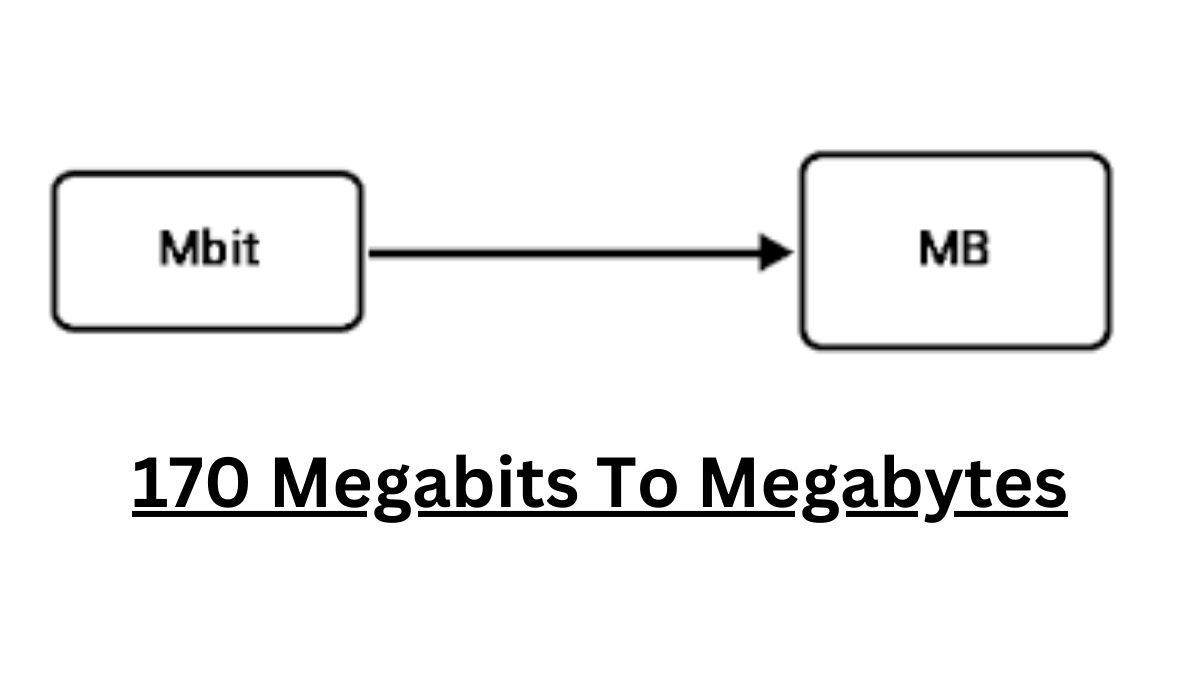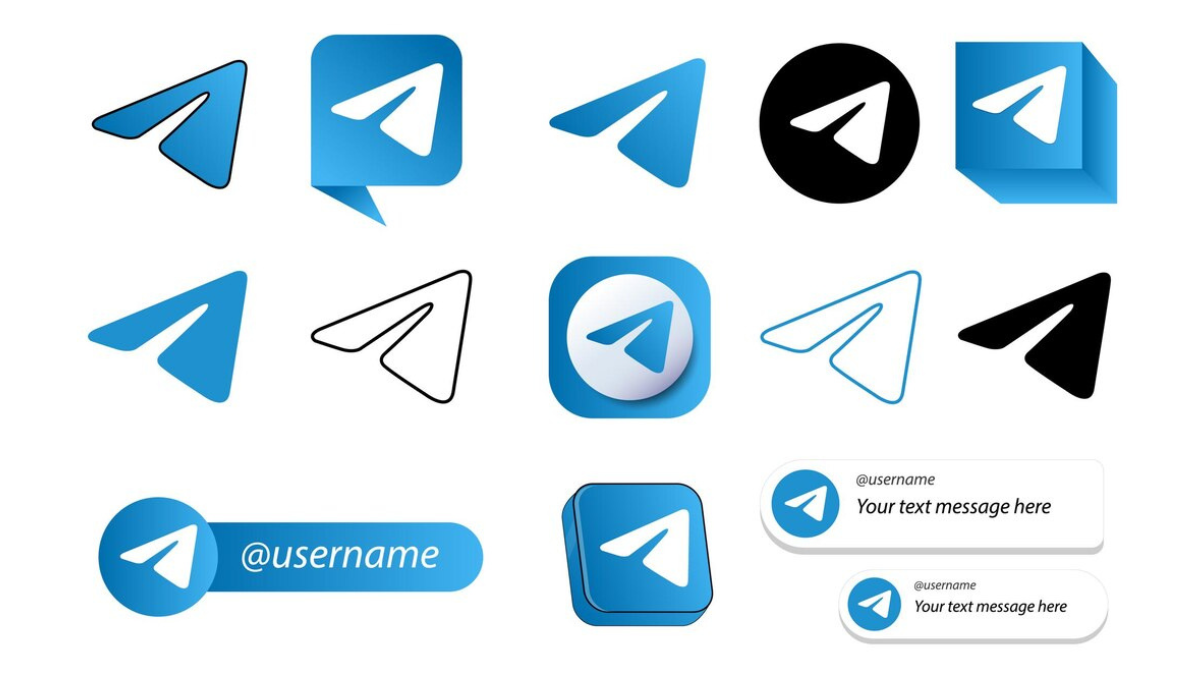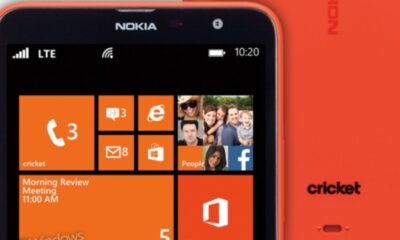Technology
Convert 170 Megabits to Megabytes

Are you feeling a bit lost in the world of data measurement? Don’t worry, you’re not alone! With all the terminology and units floating around, it’s easy to get confused. One common confusion is between megabits (Mb) and megabytes (MB). These two terms may sound similar, but they actually represent different measurements. In this blog post, we’ll guide you through the process of converting 170 megabits to megabytes and help clear up any misconceptions along the way. So let’s dive in and unravel the mystery behind these digital measurements!
Understanding the Difference Between Megabits and Megabytes
When it comes to understanding the difference between megabits and megabytes, it’s crucial to grasp the fundamentals. Both terms are used in measuring data but represent different quantities.
First, let’s tackle megabits (Mb). A bit is the most basic unit of digital information and can have two values: 0 or 1. Megabit refers to a million bits, which translates to a measurement of data transfer speed. For example, when you see an internet plan offering speeds of 100 Mbps (megabits per second), that means you can theoretically download or upload data at a rate of 100 million bits per second.
On the other hand, we have megabytes (MB). A byte consists of eight bits grouped together as a single unit. It represents storage capacity rather than speed. So when you’re talking about file sizes or memory space on your computer or mobile device, you’ll often refer to measurements in terms of megabytes.
Now that we’ve covered these basics, let’s move on to converting from megabits to megabytes!
How to Convert Megabits to Megabytes
Megabits and megabytes are units of measurement that are commonly used when it comes to data storage and transfer. However, they represent different quantities, so it’s important to understand the difference between them.
How to Convert Megabits to Megabytes
To convert megabits to megabytes, you need to know that there are 8 bits in a byte. Therefore, to convert from megabits to megabytes, you divide the number of bits by 8. In this case, we want to convert 170 megabits.
So, if we divide 170 by 8, we get approximately 21.25. This means that 170 megabits is equal to about 21.25 megabytes.
It’s worth noting that the conversion from bits to bytes can sometimes be confusing because of their similar names but different scales of measurement. Understanding this distinction is crucial for accurately calculating data sizes and ensuring efficient data transfer.
By knowing how many bits make up a byte and vice versa, you can easily perform conversions between different units of measurement like kilobits (Kbps), kilobytes (KB), gigabits (Gbps), and gigabytes (GB).
Having a clear understanding of these conversions is essential in various fields such as networking, computing, telecommunications, and digital storage where accurate measurements play a vital role in managing data effectively.
Converting from one unit of measurement to another may seem daunting at first glance. However,the process becomes much simpler once you grasp the basic principles behind it.
Examples of Conversions
Now that we understand the difference between megabits and megabytes, let’s look at some examples of how to convert 170 megabits to megabytes. Remember, there are 8 bits in a byte, so we need to divide our number of bits by 8 to get the equivalent in bytes.
To convert 170 megabits to megabytes, we first divide by 8:
170 / 8 = 21.25
So, 170 megabits is equal to approximately 21.25 megabytes.
It’s important to note that when converting between these units of measurement, it’s not always an exact conversion due to rounding. In this case, the result may be slightly different depending on whether you round up or down.
Another example would be if you have a file size of 3400 kilobits and want to know how many kilobytes it is:
3400 / 8 = 425
So, a file size of 3400 kilobits is equal to approximately 425 kilobytes.
By understanding these conversions and being able to accurately calculate them, you can ensure that you are working with accurate measurements when dealing with data storage and transfer.
Stay tuned for more tips on understanding the differences between bits and bytes!
The Importance of Knowing the Difference Between Bits and Bytes
Have you ever heard of the terms “bits” and “bytes”? If you regularly deal with digital data, it’s crucial to understand the difference between these two units of measurement.
Bits and bytes are used to quantify the amount of information stored or transferred in a computer system. A bit is the smallest unit of data and can represent either a 0 or a 1. On the other hand, a byte consists of eight bits and is commonly used as a basic unit for measuring storage capacity.
Knowing the distinction between megabits (Mb) and megabytes (MB) is particularly important when it comes to internet speeds, file sizes, and data transfer rates. Internet service providers often advertise their speeds in megabits per second (Mbps), while files on your computer are typically measured in megabytes (MB).
Confusing these two units could lead to incorrect estimations or misunderstandings about how long it will take to download or upload files, stream videos, or complete any online activities that involve transferring data.
Understanding this distinction also helps when purchasing external storage devices such as hard drives or USB flash drives. These devices usually specify their capacities in gigabytes (GB) or terabytes (TB). By knowing that there are eight bits in one byte, you can accurately calculate how many files you can store on a specific device.
In today’s digital age where we rely heavily on technology for work, entertainment, communication, and more – having an understanding of bits versus bytes is essential. It empowers us to make informed decisions related to our internet connection speed requirements as well as efficient management of our digital content.
So next time someone mentions bits or bytes while discussing internet speeds, file sizes, or storage capacities – don’t let yourself get confused! Knowing the difference between them will save you from potential frustrations down the line. Stay informed so that you can navigate through the world of digital information with confidence!
Common Misconceptions About Data Storage and Transfer
When it comes to data storage and transfer, there are several common misconceptions that can lead to confusion. One of the most prevalent misconceptions is the belief that a megabit (Mb) is equivalent to a megabyte (MB). However, this is not the case.
Another misconception is assuming that advertised internet speeds are solely based on download speed. In reality, these speeds refer to both upload and download capabilities. It’s important to consider both aspects when comparing different internet service providers.
Additionally, many people believe that transferring files between devices should be instantaneous. However, factors such as file size and network congestion can significantly impact transfer times. Understanding these limitations can help manage expectations for data transfers.
Furthermore, some individuals may mistakenly assume that all digital media files have the same file size across different platforms or formats. In truth, various compression techniques and encoding methods result in varying file sizes for the same content.
It’s essential to debunk the idea that storing data in “the cloud” means it exists somewhere ethereal without physical infrastructure. Cloud storage relies on vast networks of servers housed in data centers around the world.
By addressing these common misconceptions about data storage and transfer, we can better understand how information travels through digital networks while making informed decisions about our own usage habits and needs.
Tools for Easily Converting Between Different Units of Measurement
One of the challenges in converting between different units of measurement is keeping track of all the formulas and calculations. Luckily, there are several tools available online that can make this process much easier. These tools allow you to quickly convert values from one unit to another with just a few clicks.
One popular tool for unit conversion is UnitConvert.com. This website offers a wide range of conversion options, including conversions between megabits and megabytes. Simply enter the value you want to convert, select the desired units, and let the tool do the rest.
Another helpful tool is ConvertUnits.com. This site not only provides conversions for various units but also offers additional information and resources related to each unit. It’s a great option if you want more detailed explanations or need assistance with complex conversions.
For those who prefer mobile apps, there are plenty available for both Android and iOS devices. Apps like “Unit Converter” or “ConvertPad” offer simple interfaces and cover a wide range of units – including digital storage measurements like megabits and megabytes.
No matter which tool you choose, having access to these convenient converters can save time and prevent errors when converting between different units of measurement.
Remember: knowledge about data storage measurements is crucial when dealing with digital content! So don’t hesitate to use these handy tools whenever needed.
Conclusion
Understanding the difference between megabits and megabytes is crucial in today’s digital world. It allows us to accurately measure and convert data, ensuring seamless communication and efficient storage.
In this article, we have explored how to convert 170 megabits to megabytes. By following a simple conversion formula, we can determine that 170 megabits is equal to 21.25 megabytes.
Knowing the distinction between bits and bytes not only helps in converting measurements but also aids in understanding data storage capacities, internet speeds, and file sizes. This knowledge empowers us to make informed decisions when it comes to purchasing devices or selecting internet plans that suit our needs.
It is common for people to have misconceptions about data storage and transfer due to the complexity of units of measurement. However, by delving into the basics of bits and bytes, we can dispel any confusion surrounding these terms.
To facilitate conversions between different units of measurement effortlessly, there are various online tools available. These tools enable quick calculations without the need for manual formulas or complex calculations.
Being able to convert from megabits to megabytes opens up a whole new level of understanding when dealing with digital information. Whether you’re downloading files, streaming content online, or managing your device’s storage capacity – knowing how much data you’re working with is essential for an optimal user experience. So next time you come across a measurement in one unit while needing it converted into another unit – remember the simple formula discussed here!
Technology
Take Charge: 10 Proven Strategies for Discord Gain Control

In the realm of online communities, maintaining harmony and control can be a daunting task. Discord, a popular platform for communication and collaboration, often presents challenges in managing conflicts and maintaining order. However, with the right strategies and approaches, gaining control over discord is not only achievable but can also lead to a thriving and vibrant community. In this comprehensive guide, we’ll delve into 10 proven strategies to help you take charge and foster a positive environment within your discord community.
Establish Clear Guidelines and Rules
Setting clear guidelines and rules is essential for creating a structured environment within your discord community. By clearly outlining expectations regarding behavior, language, and interactions, you provide members with a framework for appropriate conduct. Additionally, ensure that these guidelines are easily accessible and prominently displayed to all members.
Foster Open Communication Channels
Encourage open communication channels where members feel comfortable expressing their thoughts, concerns, and ideas. By fostering an environment of transparency and openness, you promote constructive dialogue and minimize the likelihood of conflicts escalating.
Lead by Example
As a leader within the community, it’s crucial to lead by example and demonstrate the behavior you wish to see in others. Uphold the values and principles outlined in your guidelines, and actively engage with members in a respectful and positive manner.
Implement Moderation Strategies
Effective moderation is key to maintaining control and order within your discord community. Establish a team of moderators who are tasked with enforcing the rules, addressing conflicts, and ensuring that discussions remain productive and respectful.
Encourage Collaboration and Teamwork
Promote collaboration and teamwork among members by creating opportunities for joint projects, discussions, and events. By fostering a sense of camaraderie and shared purpose, you can strengthen bonds within the community and reduce the likelihood of discord.
Provide Support and Resources
Offer support and resources to members who may be struggling with conflicts or challenges within the community. Whether it’s providing guidance on conflict resolution or offering access to counseling services, demonstrating empathy and support can help mitigate discord.
Address Issues Promptly
Address issues and conflicts promptly to prevent them from escalating further. Take proactive measures to resolve disputes, mediate conflicts, and ensure that all parties involved feel heard and understood.
Cultivate a Positive Culture
Cultivate a positive culture within your discord community by celebrating achievements, recognizing contributions, and fostering a sense of belonging. Encourage positivity, optimism, and mutual respect among members.
Conduct Regular Check-ins
Conduct regular check-ins with members to solicit feedback, assess the overall health of the community, and identify any emerging issues or concerns. Use these check-ins as an opportunity to reinforce the values and principles of the community and address any areas of improvement.
Continuously Evolve and Adapt
Finally, recognize that maintaining control over discord is an ongoing process that requires continuous evolution and adaptation. Stay vigilant to changes within the community, solicit feedback from members, and be willing to adjust your strategies as needed to ensure the long-term success and sustainability of your discord community.
Discord Gain Control
Achieving control over discord within your community requires a proactive and multifaceted approach. By implementing the strategies outlined above, you can create a positive and harmonious environment where members feel valued, respected, and empowered to contribute positively. Remember, effective leadership, clear communication, and a commitment to fostering a supportive and inclusive community are key to gaining control over discord.
Conclusion:
In conclusion, gaining control over discord within your community is a multifaceted endeavor that requires proactive leadership, clear communication, and a commitment to fostering a positive and inclusive environment. By implementing the strategies outlined in this guide and prioritizing the well-being of your members, you can create a thriving discord community where collaboration flourishes, conflicts are resolved constructively, and members feel valued and supported.
FAQs:
How can I prevent conflicts from escalating in my discord community?
To prevent conflicts from escalating, it’s essential to establish clear guidelines, foster open communication, and address issues promptly. Encourage respectful dialogue and provide support to members who may be struggling with conflicts.
What role do moderators play in maintaining control over discord?
Moderators play a crucial role in enforcing rules, mediating conflicts, and ensuring that discussions remain productive and respectful. By empowering moderators to take proactive measures, you can effectively maintain order within your discord community.
Is it possible to create a positive culture within a discord community?
Yes, creating a positive culture within a discord community is achievable with the right strategies and approaches. By fostering a sense of belonging, celebrating achievements, and promoting mutual respect, you can cultivate a supportive and inclusive environment where members thrive.
How can I encourage collaboration and teamwork among members?
Encourage collaboration and teamwork by creating opportunities for joint projects, discussions, and events. Foster a sense of camaraderie and shared purpose, and provide support to members who may be interested in collaborating with others.
What should I do if conflicts arise despite my efforts to prevent them?
If conflicts arise despite your efforts to prevent them, it’s essential to address them promptly and effectively. Take proactive measures to resolve disputes, mediate conflicts, and ensure that all parties involved feel heard and understood.
How can I ensure the long-term success of my discord community?
To ensure the long-term success of your discord community, focus on effective leadership, clear communication, and continuous improvement. Stay vigilant to changes within the community, solicit feedback from members, and be willing to adapt your strategies as needed.
Technology
.vid Format: Maximizing Video Content Impact

In today’s digital landscape, video content reigns supreme. From social media to corporate presentations, videos are ubiquitous. However, with the rise of various video formats, it’s crucial to understand the nuances of each. One such format gaining traction is .vid. In this comprehensive guide, we’ll delve into everything you need to know about .vid format, from its advantages to optimization techniques.
Understanding .vid Format
· What is .vid format?
In essence, . vid format is a versatile video file extension designed for optimal playback and sharing across various platforms. Unlike traditional formats like .mp4 or .mov, .vid offers enhanced compression without compromising quality, making it ideal for online distribution.
· The Advantages of .vid Format
Harnessing .vid forma’t for your video content comes with a myriad of benefits. Firstly, its efficient compression algorithm ensures faster loading times, reducing buffering and enhancing user experience. Moreover, .vid files tend to be smaller in size, facilitating easier sharing and storage. Additionally, .vid’s compatibility across devices and platforms makes it a versatile choice for content creators.
Optimizing Your Videos in .vid Format
· Creating High-Quality .vid Content
To leverage the full potential of .vid forma’t, prioritize producing high-quality videos. Invest in professional equipment and editing software to capture and edit footage with precision. Remember, the foundation of compelling video content lies in its visual and auditory appeal.
· Optimal Compression Techniques
One of the hallmark features of .vid forma’t is its efficient compression. When encoding your videos, utilize modern codecs like H.265 to strike the perfect balance between file size and quality. Experiment with different compression settings to find the optimal configuration for your content.
· Enhancing Accessibility and SEO
Incorporating closed captions and transcripts not only improves accessibility but also boosts SEO. Search engines index textual content, making your videos more discoverable to a wider audience. Additionally, include relevant keywords in your video titles, descriptions, and tags to improve search engine rankings.
Best Practices for .vid Format Implementation
· Cross-Platform Compatibility
Ensure your videos are compatible across various devices and operating systems. Test playback on different browsers and devices to guarantee a seamless viewing experience for your audience.
· Engagement Optimization
Encourage viewer interaction by incorporating interactive elements such as clickable annotations or embedded links. Foster community engagement through comments, likes, and shares to amplify your video’s reach.
· Analytics and Iteration
Utilize analytics tools to gain insights into viewer behavior and preferences. Analyze metrics such as watch time, engagement rate, and audience demographics to refine your content strategy iteratively.
Conclusion
In conclusion, embracing .vid forma’t offers a myriad of opportunities for content creators to elevate their video content. By understanding its nuances and implementing optimization techniques, you can maximize the impact and reach of your videos across digital platforms.
Visit For More: windowsphonedaily
FAQs (Frequently Asked Questions)
How does .vid format differ from traditional video formats like .mp4?
.vid forma’t utilizes advanced compression algorithms, resulting in smaller file sizes without sacrificing quality, unlike traditional formats.
Can I convert existing video files to .vid format?
Yes, various online converters and software tools allow you to convert existing video files to .vid forma’t effortlessly.
Is .vid format compatible with all video editing software?
While .vid forma’t is widely supported, it’s essential to ensure compatibility with your preferred video editing software.
Are there any limitations to .vid format?
While .vid forma’t offers numerous advantages, it’s essential to consider potential compatibility issues with older devices or software versions.
How can I optimize my website for .vid content?
Incorporate .vid files strategically within your website’s design, ensuring seamless integration and optimal user experience.
Can .vid format improve my video’s SEO performance?
Yes, by incorporating relevant keywords and metadata, .vid forma’t can enhance your video’s discoverability and search engine rankings.
Technology
Potential of Pornografia Telegram: A Comprehensive Guide

Welcome to the ultimate guide on pornografia telegram. In today’s digital age, communication and information-sharing have evolved significantly. Porno-grafia telegram emerges as a powerful platform offering unique benefits and opportunities for users. Whether you’re a content creator, marketer, or enthusiast, understanding the intricacies of porno-grafia telegram can unlock a world of possibilities. This guide aims to delve deep into the functionalities, advantages, and best practices surrounding porno-grafia telegram, ensuring you harness its full potential.
Understanding Pornografia Telegram
Venture into the realm of porno-grafia telegram, where innovation meets communication. This section provides an overview of what porno-grafia telegram is and how it functions. From its inception to its current standing in the digital landscape, uncover the essence of this platform.
Pornografia Telegram: A Haven for Content Enthusiasts
Embark on a journey through the dynamic landscape of porno-grafia telegram. Dive into its diverse features and capabilities, catering to the needs of modern content creators and consumers alike.
Exploring the Features of Pornografia Telegram
Delve deeper into the functionalities that make porno-grafia telegram a standout platform in the digital sphere. From its seamless interface to its robust security measures, discover why millions flock to porno-grafia telegram for their content needs.
Enhanced Security Measures: Safeguarding Your Privacy
Privacy concerns are paramount in today’s interconnected world. Explore how porno-grafia telegram prioritizes user security through end-to-end encryption and other advanced features, ensuring a safe and secure environment for all.
Maximizing Your Presence on Pornografia Telegram
Unleash the full potential of porno-grafia telegram by optimizing your presence on the platform. Whether you’re a content creator, marketer, or business owner, implementing effective strategies can elevate your visibility and engagement.
Creating Compelling Content: Captivating Your Audience
Content is king in the digital realm, and porno-grafia telegram offers a fertile ground for creativity. Learn how to craft engaging content that resonates with your audience, driving traffic and fostering meaningful connections.
Utilizing Pornografia Telegram for Marketing Purposes
Discover the myriad ways in which porno-grafia telegram can serve as a powerful tool for marketing initiatives. From building brand awareness to driving conversions, leverage the platform’s unique features to enhance your marketing endeavors.
Engaging with Your Audience: Fostering Community Connections
Building a strong community is essential for sustained success on pornografia telegram. Explore strategies for fostering meaningful interactions, cultivating loyalty, and nurturing a vibrant online community around your brand or content.
Conclusion
In conclusion, porno-grafia telegram emerges as a dynamic platform offering a wealth of opportunities for content creators, marketers, and enthusiasts alike. By understanding its features, maximizing your presence, and leveraging effective strategies, you can unlock the full potential of porno-grafia telegram and propel your online endeavors to new heights.
FAQs (Frequently Asked Questions)
What makes pornografia telegram different from other messaging platforms?
Porno-grafia telegram stands out for its commitment to privacy, security, and versatility. Unlike traditional messaging platforms, porno-grafia telegram offers end-to-end encryption, self-destructing messages, and a host of other features tailored to content creators and consumers.
How can I join pornografia telegram?
Joining porno-grafia telegram is easy and straightforward. Simply download the app from the App Store or Google Play Store, create an account, and start exploring the platform’s myriad features and communities.
Is pornografia telegram suitable for businesses and marketers?
Absolutely! Porno-grafia telegram offers a wealth of opportunities for businesses and marketers to connect with their target audience, drive engagement, and promote their products or services effectively.
Can I monetize my content on pornografia telegram?
Yes, you can monetize your content on porno-grafia telegram through various means, such as premium subscriptions, exclusive content, and sponsored posts. With the right approach, you can turn your passion into profit on this platform.
Is pornografia telegram safe to use?
Yes, porno-grafia telegram prioritizes user privacy and security. With features like end-to-end encryption and self-destructing messages, you can rest assured that your conversations and data are protected from prying eyes.
How can I increase my followers on pornografia telegram?
Building a following on porno-grafia telegram requires consistent effort and engagement. Share high-quality content, interact with your audience, and leverage hashtags and communities to expand your reach and attract new followers.
Fore More Visit: windowsphonedaily
-

 Technology8 months ago
Technology8 months agoWhat is a Network Termination Unit (NTU)?
-

 General7 months ago
General7 months agoIntroduction to the Concept of a Favorite Daughter
-

 Travel8 months ago
Travel8 months agoExploring the Wonders of myfavouriteplaces.org:// blog
-

 Technology5 months ago
Technology5 months ago.vid Format: Maximizing Video Content Impact
-

 Technology8 months ago
Technology8 months agoInstagram Stories No Sound: Unveiling the Silence Dilemma
-

 News6 months ago
News6 months agoNokia Lumia 1320 now available from Cricket Wireless for $229 after rebate
-

 Celebrity8 months ago
Celebrity8 months agoMatthew Mcconaughey Net Worth
-

 Technology5 months ago
Technology5 months agoAmazon GPT-55X: Revolutionizing AI-Powered Solutions
